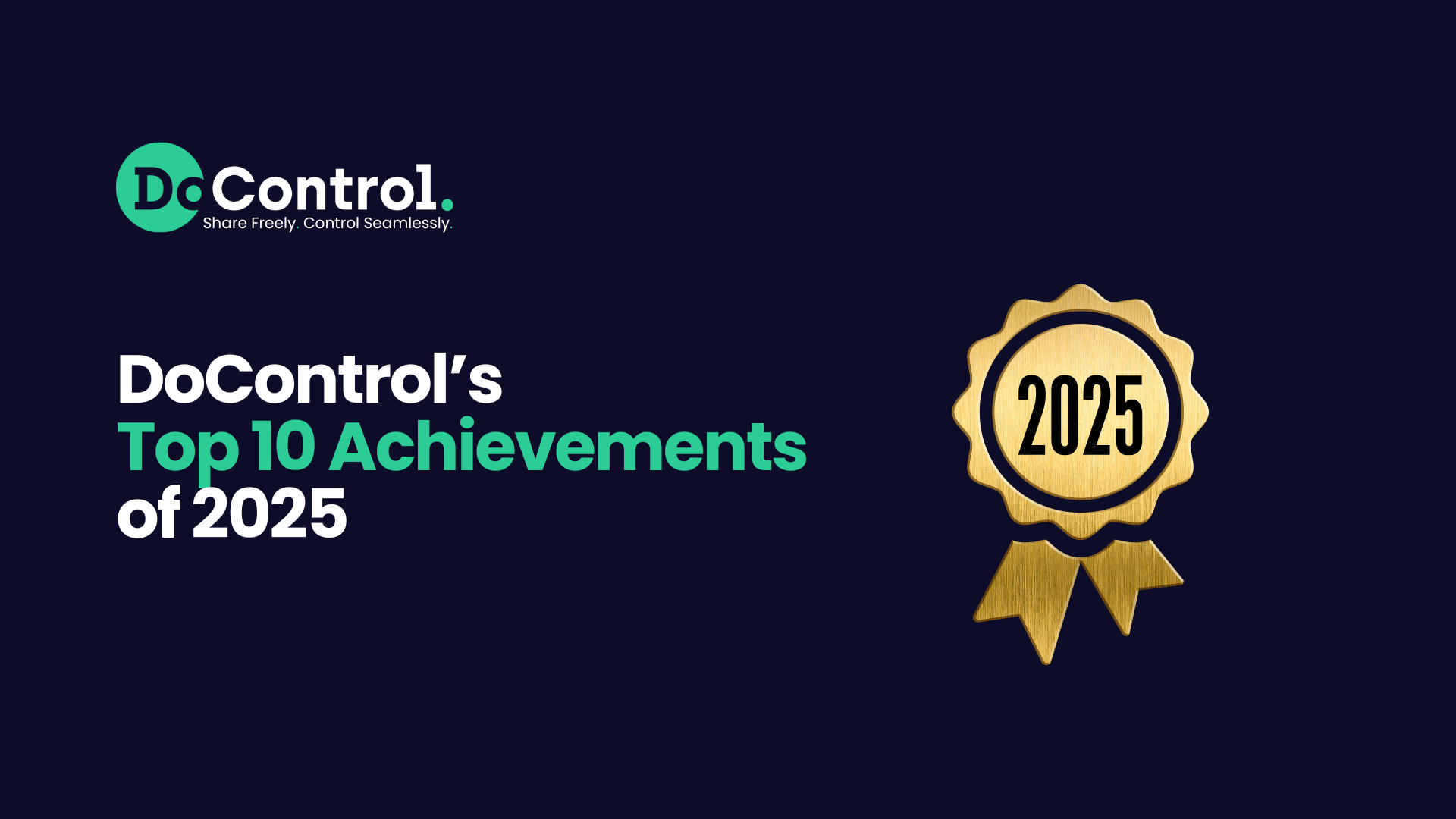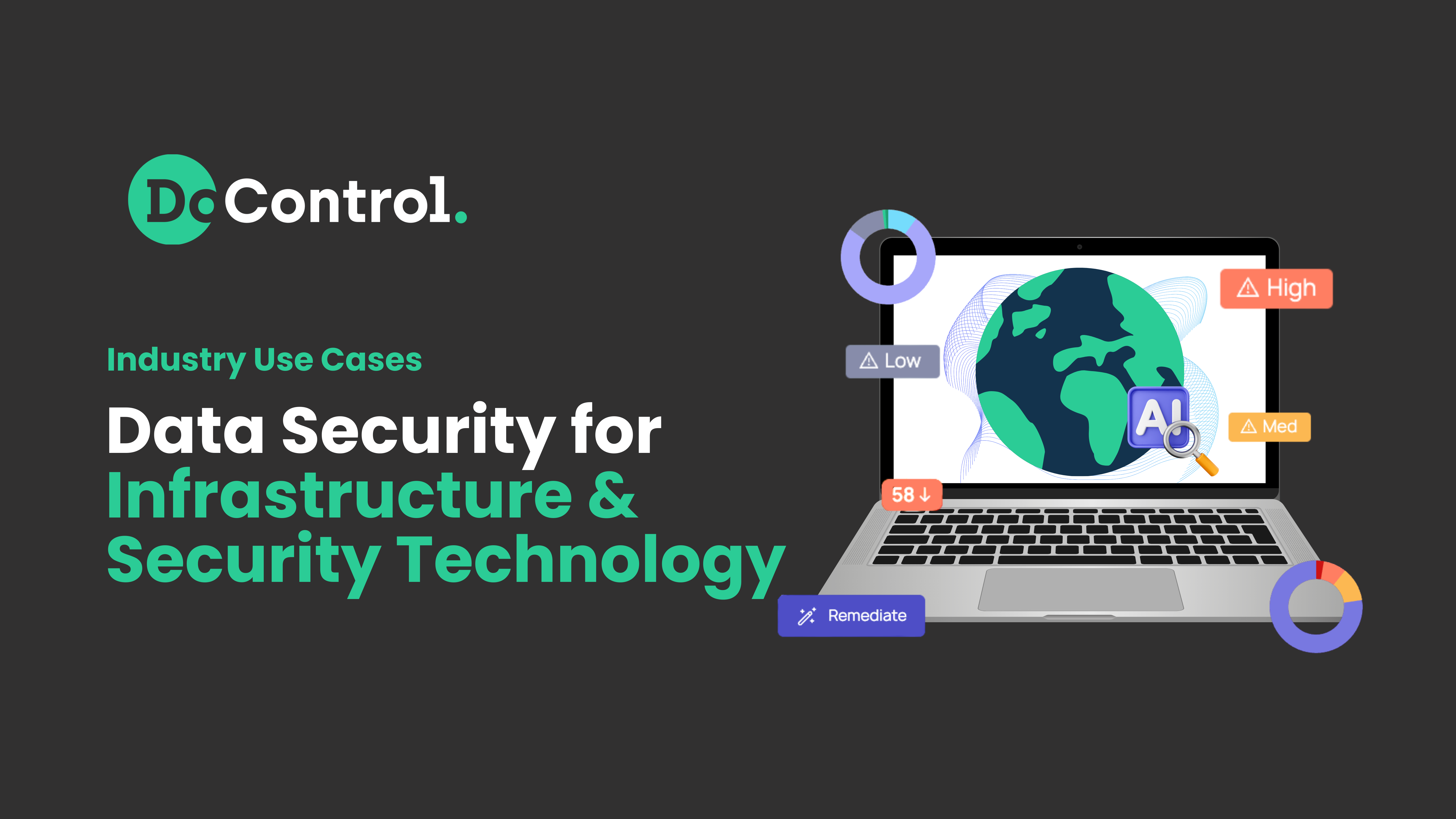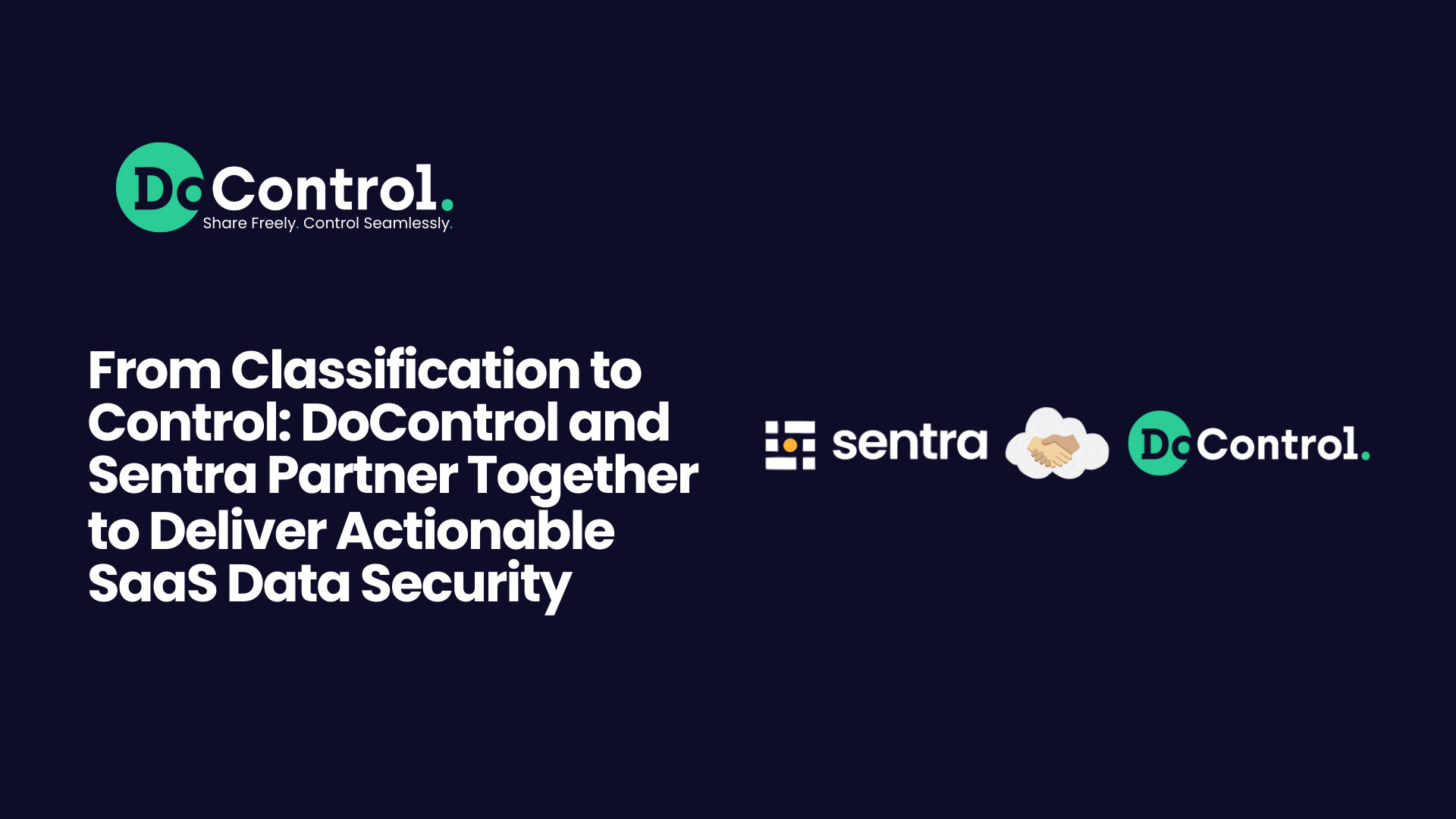.png)
In 2025, cloud-based solutions like Google Drive have become indispensable for business operations worldwide. However, with the convenience of storing and sharing data online comes the critical question of security.
A recent analysis by DoControl of our enterprise-level Google Workspace clients uncovered alarming data security risks. On average, companies had 709,533 publicly exposed Google Drive assets containing sensitive information – accessible to anyone with the link.
The exposure levels for insider threats was even more troubling, with organizations averaging 120,000 sensitive assets downloaded and shared with a personal email address. This widespread overexposure highlights critical gaps in access controls, leaving organizations vulnerable to data leaks and compliance risks.
This post will provide a comprehensive overview on Google Drive security, diving into admin & user responsibilities, protections, compliance considerations, and effective strategies to help organizations secure their data effectively.
Is Google Drive Secure in 2025? A Quick Answer
The short answer? Somewhat. While Google Drive offers robust security features, whether it is 100% secure for storing and sharing sensitive company data is not a simple yes or no – it depends on how well it is managed.
Google Drive security is built on three key pillars: data protection, access control, and compliance. Google Drive employs encryption in transit and at rest to protect data integrity, a robust access control framework to regulate file interactions, and adherence to global compliance standards to ensure regulatory alignment.
For an in-depth analysis of Google Drive encryption, the various types of encryption, and Drive’s lack of end-to-end encryption, what Google can and can’t store when it comes to encryption information, read our Google Drive encryption guide.
However, under the shared responsibility model, Google secures only the infrastructure, while businesses remain responsible for managing permissions, user education, and access controls to prevent unauthorized exposure.
Security threats in Google Drive generally fall into two categories:
- Data Infiltration: The introduction of malicious files or unauthorized access to your Drive. This includes malware-infected documents, phishing attempts, or hackers altering sensitive data.
- Data Exfiltration: The unintended or malicious removal of data from your domain. This includes external sharing of sensitive docs or files, employees transferring company data to personal accounts, or misconfigurations that make critical documents publicly accessible. Exfiltration is both an operational risk (potential exposure of trade secrets) and a compliance risk (leading to regulatory penalties).
While Google implements security measures to mitigate both infiltration and exfiltration risks, its built-in protections & services alone are not enough to protect your files.
Sensitive business data stored in Google Drive is ultimately the responsibility of the organization, requiring additional security controls, strict access policies, and proactive monitoring to safeguard against threats.
What Google Protects vs. What You’re Responsible For
Like any cloud service, Google Drive security follows a shared responsibility model. While Google provides foundational protections, securing data within an organization ultimately requires admins and end users to manage access controls, monitor activity, and prevent unintentional exposure.
Google’s Responsibilities
Google’s primary role is data protection through encryption. All files in Google Drive are encrypted both in transit and at rest. By default, files are private unless explicitly shared, offering a baseline defense against accidental exposure.
However, Google does not provide zero-knowledge encryption, meaning it retains access to encryption keys and could decrypt data if required by law or compromised in a breach.
Organizations handling highly sensitive documents need to implement additional encryption solutions to maintain full control over their data security, such as client-side encryption, which ensures that only the end user has access to the encryption keys, preventing even Google from decrypting the files.
To prevent data infiltration, Google scans externally shared files for malware and phishing threats, blocking access if a risk is detected. However, these protections are reactive and do not prevent internal risks – such as an employee mistakenly sharing confidential files with unauthorized parties.
What End Users Are Responsible For
Individual users play a crucial role in securing their own accounts and shared files. They are responsible for keeping their own Google account safe. There are certain actions users can take to make their Drive more secure. Strong passwords, password managers, two-factor authentication, or multi-factor authentication (MFA) are essential to protecting Google Workspace accounts from unauthorized access.
Beyond account security, users must be vigilant about sharing settings. A single misconfiguration – such as setting a sensitive document to “Anyone with the link can view” – can expose critical data to the public, leading to operational and regulatory consequences.
What Admins Are Responsible For
Admins (typically IT or security teams) are responsible for enforcing security settings and policies - constantly monitoring their Google Drive environment to mitigate data exfiltration risks. This includes:
- Access Controls: Restricting re-sharing, downloading, printing, and permission changes to prevent unauthorized data exposure.
- Endpoint Management: Enforcing device encryption, screen locks, remote signouts, and remote wipes for lost or stolen devices.
- Security Monitoring: Using audit logs, security reports, and alerts to detect suspicious activity and unauthorized file access.
Google also provides Data Loss Prevention (DLP) tools, which allow admins to scan Drive files for sensitive information (e.g., Social Security numbers, financial records) and enforce restrictions like blocking sharing, disabling downloads, or triggering alerts.
However, while DLP adds an extra layer of security, it has significant limitations and does not provide granular access controls. Organizations typically need additional security measures to fully protect sensitive files.
The Most Common Threats Inside Google Drive
While Google Drive offers built-in security features & services to keep the majority of files safe, several common threats can still put sensitive business data at risk. Organizations must proactively address these risks to prevent data breaches, unauthorized access, and compliance violations.
1. Phishing & Credential Theft
Attackers frequently use phishing tactics or social engineering to trick users into entering their credentials on fake login pages, granting unauthorized access to Google Drive accounts. Multi-factor authentication (MFA) and regular user education on spotting phishing attempts are critical in mitigating these risks.
2. Oversharing & Misconfigured Access
Users often use Google to publicly share files with “Anyone with the link” for convenience, unknowingly exposing sensitive data to unauthorized parties. Without strict, granular access controls and visibility into shared files, confidential information–such as financial documents or customer data–can be left accessible to the public.
3. Malicious or Over-Permissioned Apps
Many third-party applications integrate with Google Drive for productivity, but they can over-request permissions or even be malicious. Without regular app audits to monitor permissions and data access, organizations risk exposing Drive assets to unauthorized third-party tools.
4. Incomplete Offboarding & Residual Access
Failing to revoke access for former employees or contractors is a major security gap. If former employees retain permissions to Drive files, they can still access, modify, or share critical company data. A strict offboarding process should ensure all accounts, applications, and data access are fully deactivated upon departure.
These threats highlight the importance of continuous monitoring, strong access controls, and proactive security measures to keep Google Drive environments secure.
How to Secure Google Drive: The Complete Checklist
Protecting Google Drive requires a combination of strong access controls, user education, and proactive security measures. Use this checklist to minimize risks and secure sensitive data effectively.
- Configure Information Rights Management (IRM): Set Google Workspace policies to limit re-sharing, downloading, printing, copying, or changing permissions to reduce accidental or intentional data exposure.
- Require Multi-Factor Authentication (MFA): Users can prevent unauthorized access by enforcing MFA. Even if credentials are compromised, attackers won’t be able to access accounts without a second verification step.
- Educate End Users on Secure File Sharing: Reduce data leaks by training users on proper sharing settings, the risks of oversharing, and real-time security alerts when risky actions occur.
- Enable Security Alerts for Suspicious Activity: Set up email-based alerts to detect unusual behavior. Google Workspace provides administrators with tools like audit logs, security reports, and a security center with information about how files have been shared.
- Implement Endpoint Management: Endpoint management capabilities include device encryption, screen lock, password enforcement, remote signout and remote wiping of corporate accounts should devices be lost or stolen.
- Review & Remove Over-Permissioned Third-Party Apps: Conduct regular audits of third-party OAuth apps to ensure they aren’t over-permissioned or unused, reducing unnecessary exposure.
- Deploy a Cloud Access Security Broker (CASB): A CASB enhances security by detecting data leaks, preventing unauthorized file sharing, and mitigating risks from over-permissioned apps. Choose between Google’s native CASB or a third-party solution like DoControl.
By implementing these security best practices, organizations can significantly reduce the risk of data breaches, unauthorized access, and compliance violations within Google Drive.
Is Google Drive Compliant with GDPR, CCPA & SOC 2?
Google’s privacy framework aligns with major global data protection regulations like GDPR, CCPA, and SOC 2.
Google Workspace provides built-in compliance tools, such as AI-powered data classification, which automatically tags files with labels like “Confidential” or “PII” to help organizations manage sensitive data.
However, compliance isn’t automatic – organizations must make access controls a priority within their data classification strategy, and data protection policies internally.
Gaps remain within Google’s native security capabilities. For example, Google’s DLP doesn’t cover all file types or sizes and doesn’t apply retroactively to existing data. Additionally, while Google secures data stored within Drive, third-party integrations and oversharing can still expose sensitive information.
Why Employee Behavior Still Poses the Biggest Risk
When sharing files, employees often select “Anyone with the link” out of convenience, making files publicly accessible when they shouldn't be. These public files are then available for anyone on the internet to see. In some cases, employees may share files with personal email, creating a huge risk. Whether intentional or not, that file is now permanently in their possession, forever.
Employees also frequently use Google Drive to collaborate with contractors, vendors, or third-party agencies, but when a project ends, access to google docs or sheets that contain sensitive information often isn’t revoked. This leaves sensitive company data exposed to external parties indefinitely.
There are also huge risks that pertain to about-to-leave or terminated employees. DoControl data found that 94,000 assets remain exposed to former employees. These employees that can access critical company information - even after they’ve left the company - are a huge risk with detrimental repercussions.
These employee-driven risks lead us to the issue of remediation. Google’s native capabilities don’t allow for bulk unsharing of historical files or revoking over-permissioned third-party apps at scale. Without regular audits, data exposure accumulates over time, increasing security risks and leaves these sensitive files out there. So, what do you do?
How DoControl Mitigates Employee-Driven Risks
DoControl provides visibility, automation, and enforcement to ensure employee behavior doesn’t become a security liability. With DoControl, you can:
- Keep tabs on all employee behavior; be in the know about who is sharing what, when, and with whom – all in real time.
- Sync Google Workspace with HRIS or IDP systems that aggregates employee data to assess whether their file-sharing actions are routine or high-risk.
- Receive a dynamic risk score to each employee, based on aggregated data about their event-based / file sharing behavior and context from HRIS or IDP systems.
- Unshare or delete up to a million historical assets in one click, ensuring past oversharing doesn’t remain a long-term security threat and new data stays safe.
By addressing these behavioral risks with automation and proactive controls, organizations can drastically reduce exposure and insider threats in Google Drive.
Automating Your Google Drive Security Strategy
DoControl continuously monitors events and takes action in real time, working 24/7 so you don’t have to. Security teams can even create custom workflows to meet diverse scenarios their organization may face.
Through our workflows, any suspicious activity is either automatically mitigated, or escalated to IT and security teams with automated actionable alerts – ensuring threats are addressed immediately without manual intervention.
We are built to secure every layer of Google Drive’s attack surface – including data, identities, configurations, and connected apps:
- Data Access Governance & Data Loss Prevention: DoControl continuously secures your Google Drive data with advanced classification methods that uncover all sensitive information. Automated workflows detect and mitigate threats in near real-time, preventing data leaks and unauthorized access.
- Identity Threat Detection & Response (ITDR) & Insider Risk Management: Protect against both external attackers and insider threats with behavioral benchmarking, insights from business-critical SaaS applications, and context from HRIS, EDR, and IdP systems. This ensures smart differentiation between normal activity and suspicious actions.
- Shadow App Discovery & Remediation: Monitor and control third-party OAuth applications, automatically removing unnecessary apps and over-permissioned integrations that pose security risks.
- SaaS Misconfiguration Management: Ensure Google Workspace admin configurations align with industry standards like CIS, with automated audits and remediation recommendations to maintain a secure environment.
Make Google Drive Security a Priority
Google Drive has the highest market share of any global cloud file sharing software, among individuals and among organizations. Companies love using Google Drive - and when combined with proactive security measures, it is a no-brainer for organizations.
So, how secure is Google Drive? As you’ve probably gathered by now, it isn’t so black and white. The nuances to Google Drive security are filled with grey area.
What we do know is this: by leveraging Google’s built-in protections, filling in the gaps with third-party solutions like DoControl, and implementing best practices like user education and robust access policies, organizations can minimize data exposure risks and keep their Google Drive safe as best as they can.
Securing Google Drive is an ongoing process that – with careful management – can provide businesses with both peace of mind and enhanced productivity for years to come.
FAQ'S
Is Google Drive secure enough for storing sensitive business data?
Google Drive offers some native security features like encryption, access controls, and DLP tools, but those alone aren’t enough for enterprise needs. The biggest challenge isn’t the platform itself, it’s how users and employees interact with it. Without visibility into file sharing, external access, and third-party integrations, sensitive data can slip through the cracks. With the right guardrails and security controls in place - often provided by a third party security solution - Google Drive can absolutely support secure, compliant data storage.
What are the biggest security risks for Google Workspace users?
The most common risks include overshared files, unmanaged external collaborators, and excessive third-party app access. It’s easy for users to share sensitive data externally (intentionally or not) especially through public links or personal Gmail accounts. Without automated monitoring and remediation, these risks build up over time, leaving your organization exposed. Third-party apps accessing Drive data can also introduce unseen vulnerabilities.
Who is responsible for securing data in Google Drive, Google or my company?
Both Google and your company share responsibility for security. Google protects the underlying infrastructure, handles encryption, and maintains its servers. Your company is responsible for managing user access, setting sharing permissions, training employees, and using security tools to protect your data. While Google has some native security capabilities, your in-house IT or security team is responsible for how the data is protected, how users interact with that data, and in ensuring that the data stays protected.
How can admins prevent accidental data leaks in Google Drive?
Admins can set up strong sharing policies, use Data Loss Prevention (DLP) tools, and regularly audit shared files and permissions. Training users on secure sharing and enabling features like two-factor authentication also help reduce mistakes. Ongoing monitoring and quick action to remove risky access are essential steps. It's recommended that admins use a third-party security solution to prevent unauthorized data exposure.
What tools help reduce insider threats on Google Drive?
Data Loss Prevention (DLP) tools can block unauthorized sharing or downloading of sensitive files. Third-party platforms such as DoControl provide advanced monitoring, automate access reviews, and alert admins to suspicious user behavior. Regular audits, strong access controls, and employee training are also important to limit insider risks.
How does DoControl strengthen Google Drive security?
DoControl uses advanced methods to detect and block risky file sharing, automate security policies, and identify suspicious user actions. It offers real-time monitoring, insider threat prevention, and management of third-party app permissions. This gives organizations more control and faster response to potential security threats in Google Drive.
Want to Learn More?
See a demo - click here
Get a FREE Google workspace security risk assessment - click here
See our product in action - click here



